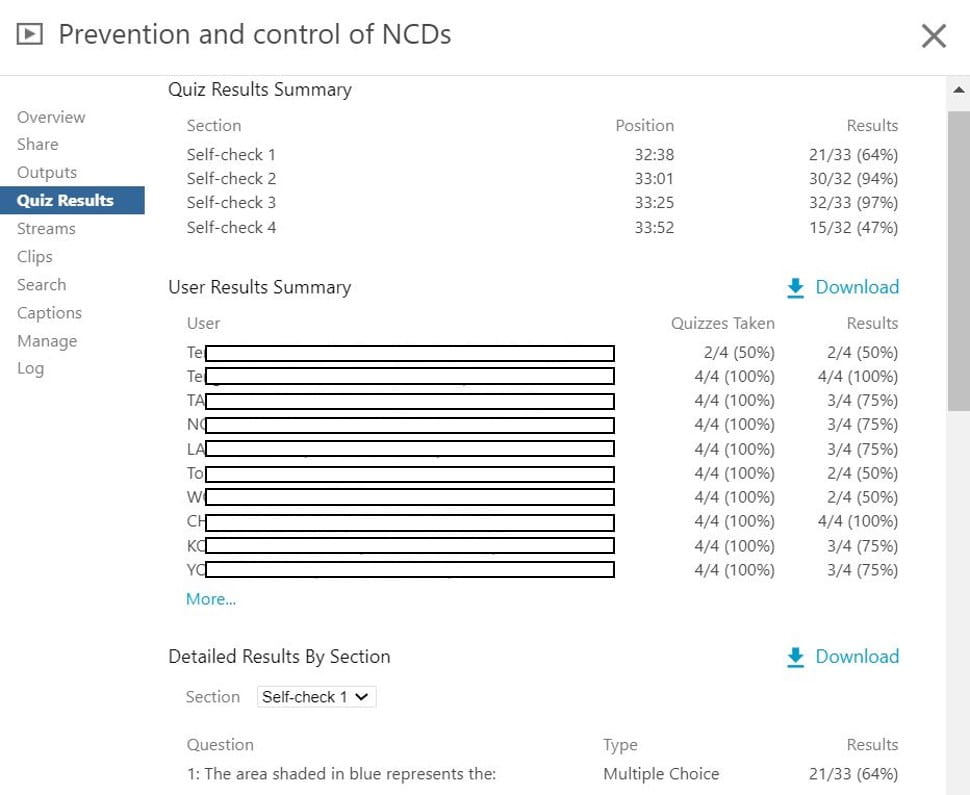Cecilia TENG Woon Chien
Saw Swee Hock School of Public Health
Cecilia explores incorporating embedded quizzes and captions in her pre-recorded video lectures (PVLs) to enhance sustained learning and student engagement.

Recommended Citation
Teng, C. W. C. (2021, Aug 13). Enriching pre-recorded video lectures to sustain engaged learning. Teaching Connections. https://blog.nus.edu.sg/teachingconnections/2021/08/13/enriching-pre-recorded-video-lectures-to-sustain-engaged-learning/
Traditionally an essential delivery medium in massive open online courses (MOOCs), pre-recorded video lectures (PVLs) have been increasingly used in other contexts, given its increased adoption in remote learning during COVID-19. While there has been much emphasis on engaging students in live face-to-face classes, conversations on student engagement in asynchronous online learning contexts are less common.
As with many colleagues in the teaching community, I had to grapple with learning new technologies while teaching remotely over the past few semesters. For lectures in various modules, I used both real-time Zoom sessions and asynchronous PVLs, the choice of which was guided by findings from a survey that I conducted, shared previously in an earlier post (Teng, 2020).
The advantages of conventional PVLs include flexibility and self-paced learning. However, when it comes to the disadvantages, besides reduced attention span, students have raised other concerns such as unclear audio, or having difficulty following sessions when there was much more mentioned verbally than what was displayed on the slides, all of which adversely affect remote learning. Similar issues have been reported by Lange and Costley (2020), among others.
In light of these, the question I asked myself was: How can we improve sustained engaged learning in asynchronous PVLs?
Using Embedded Quizzes and Captions to Enrich PVLs
To address the abovementioned challenges, I explored various software and their built-in functions, and eventually enriched my PVLs with two features: embedded quizzes and captions, both using a single platform (Panopto) (Figure 1).
Figure 1. Sample of a pre-recorded video lecture (PVL) on “Climbing in the Olympics”.
Tips and Considerations
Below are some tips and considerations based on ‘trial and error’:

Click on this link if you have trouble opening the infographic.
Student Feedback
Student feedback showed that the enriched PVLs were well-received and supported learning. Specifically, the embedded quizzes fostered sustained engagement by stimulating thinking, reinforcing concepts, and sustaining attention on task. The captions made the video lectures “clear”, helped students “follow through the lectures more easily”, and were “immensely helpful in note-taking”. Attempting questions and note-taking have been shown to support scaffolding in video-based instruction by stimulating deep learning through the reorganisation and association of knowledge and concepts (Delen et al., 2014). There was also a bonus: I could monitor student learning via “Quiz results” in Panopto (Figure 5). This also allowed me to identify areas where students are commonly confused about and signal further provision of feedback.

Concluding Thoughts
Online learning environments will continue to play an important role in teaching and learning, as flipped classroom and blended learning approaches become more widely adopted in a post-COVID-19 world. I intend to continue using enriched PVLs for selected lessons when physical classes resume.
A final suggestion for those who may be keen to enrich their PVLs: If you are facing time constraints, forgo captioning, or you can inform students to use live captioning features on some browser platforms1. However, I would still recommend incorporating quizzes in PVLs as it is a feasible change that can make all the difference. In addition, the use of technology alone does not translate to good teaching, and neither is the use of enriched pre-recordings a “one size fits all”; rather, it is how we use technology to effect learning that matters.
 |
Cecilia TENG Woon Chien is a lecturer from the Saw Swee Hock School of Public Health. She currently teaches undergraduate public health modules, and is passionate about exploring creative ways to increase student engagement. Most of all, she misses interacting with youths in-person. Cecilia can be reached at ephtwcc@nus.edu.sg. |
Endnote
- As of March 2021, Google Chrome has a live caption feature (click the Media Control button located to the right of the address bar) that allows its users to enable English captions for video and audio, although the transcription may not be 100% accurate.
References
Delen, E., Liew, J., & Willson, V. (2014). Effects of interactivity and instructional scaffolding on learning: Self-regulation in online video-based environments. Computers & Education, 78, 312-320. https://doi.org/10.1016/j.compedu.2014.06.018
Lange, C., & Costley J. (2020). Improving online video lectures: learning challenges created by media. International Journal of Educational Technology in Higher Education;17, 1-8. https://doi.org/10.1186/s41239-020-00190-6
Teng, C. (2020, November 18). Online lectures: Which format is best, when?! Incorporating the student voice in remote teaching and learning. Teaching Connections. https://blog.nus.edu.sg/teachingconnections/2020/11/18/online-lectures-which-format-is-best-when-incorporating-the-student-voice-in-remote-teaching-and-learning/

